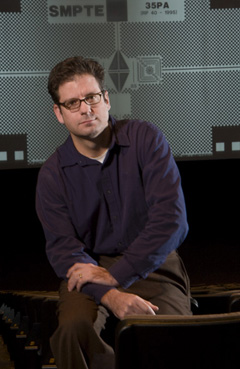Film Studies Faculty Speaks on Technicolor Process at Museum of the Moving Image
| Posted 11/05/07 |
 In the 1930s, Hollywood unveiled a new way of watching film with the introduction of three-color Technicolor. In the 1930s, Hollywood unveiled a new way of watching film with the introduction of three-color Technicolor.
Scott Higgins, left, associate professor of film studies, will speak on the 75-year-old color film process technique during a three-weekend retrospective of Technicolor films at the Museum of the Moving Image in New York City. His lecture, which begins at 2 p.m. Nov. 17, will be held in conjunction with the publication of his book Harnessing the Technicolor Rainbow: Color Design in the 1930s (University of Texas Press). Filmmakers had already mastered the art of monochrome, of translating stories into a world of black and white, light and shadow. Technicolor was both a threat and a gift, Higgins explains. Now cinematographers, set designers, and directors had to consider how to guide the viewers attention, highlight key actions, and underline dramatic developments with this new tool. On one hand, color was thought distracting, glitzy and detrimental to drama. On the other hand, it could offer a new emotional register, a new form of spectacle, and a fresh way to shape the image. Although many producers and filmmakers initially resisted the use of color, Technicolor designers developed an aesthetic that complemented the classical Hollywood filmmaking style while still offering innovative novelty. By the end of the 1930s, color in film was thoroughly harnessed to narrative, and it became elegantly expressive without threatening the coherence of the film’s imaginary world. Higgins’ book, published in November, is the first scholarly history of Technicolor aesthetics and technology, as well as a thoroughgoing analysis of how color works in film. He draws on extensive primary research and close analysis of well-known movies, including Becky Sharp, A Star Is Born, Adventures of Robin Hood, and Gone with the Wind, to show how the Technicolor films of the 1930s forged enduring conventions for handling color in popular cinema. Higgins argues that filmmakers and designers rapidly worked through a series of stylistic modes based on the demonstration, restraint, and integration of colorand shows how the color conventions developed in the 1930s have continued to influence filmmaking to the present day. Technicolor taught filmmakers how to use a broad palette to tell stories. But in the past 10 years or so, digital techniques have returned colors pride of place in popular filmmaking. Filmmakers again face a new color technology and we can see them repeating some of the aesthetic struggles of the early Technicolor era, Higgins says. He sites films like O Brother Where Art Thou and The Aviator, which use this digital technology to emulate the old Technicolor look. Other productions like Sin City and 300 revel in colors power and experiment with its potentials in a manner akin to the earliest three-color Technicolor films. It is a very exciting time for color in the cinema, quite like the 1930s in that regard, he says. He also formulates a new vocabulary and a method of analysis for capturing the often-elusive functions and effects of color that, in turn, open new avenues for the study of film form and lay a foundation for new work on color in cinema in the 312 page book. Higgins will host a book signing after his lecture, and the museum will continue its celebration of Glorious Technicolor! through Dec. 2. The first three-strip Technicolor feature, Becky Sharp (released in 1935), and the first commercial three-strip cartoon, Flowers and Trees (released in 1932), will be shown at the museum. A rare, three-strip camera used by the Technicolor Motion Picture Corporation will be on display. For more information about the Museum of the Moving Image Glorious Technicolor event go to: http://www.movingimage.us/. For more information about Higgins book, or to order the book, go to: |
| By Olivia Drake, Wesleyan Connection editor |

